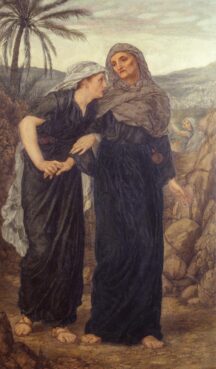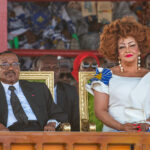(RNS) — In Los Angeles this summer and Chicago in recent weeks, U.S. Immigration and Customs Enforcement agents have detained hundreds of people, often violently, adding to widespread concerns about Trump administration policy and how it’s being carried out. People who turn to the Bible as a source of moral and political authority have been looking to its narratives for guidance on how to understand this moment. Demonstrators and administration officials alike, meanwhile, have in their own ways attempted to use the Bible to influence public opinion.
In fact the Hebrew Bible and the New Testament offer conflicting accounts for how communities should treat outsiders. The law codes preserved in the books of Leviticus, Numbers and Deuteronomy especially prescribe care for society’s most vulnerable, especially the widow, the orphan and, importantly, the foreigner. But these ancient codes are also concerned with maintaining Israel and Judah’s distinct identity and explicitly condemn intermixing with other “foreign” groups.
This exclusionary spirit is clearly evident in the Book of Ezra, a text likely written in the 400s B.C.E. In a heart-wrenching scene related in the book’s ninth and tenth chapters, Ezra, a leader in the recently reestablished Judean community in Jerusalem, oversees the expulsion of more than 100 nameless foreign women who have married Judean men, along with their offspring. These women and their children are not given a voice or an opportunity to protest. Instead, they are sent off in the rain. The reasoning for their exclusion, according to the text, lay in the women’s presumed ability to persuade their Judean men to follow other gods.
But another book in the Hebrew Bible that is perhaps under-appreciated for its reflections on the immigrant experience is the Book of Ruth. Its story of dedication, care and acceptance may offer us more insights into how to deal with the current political moment.
Set in the period of the judges a millennium before Ezra but likely written around the same time, Ruth’s story offers a dramatically different vision of how one should treat a foreigner. Ruth, a woman from Moab, in modern Jordan, migrates after the death of her Judean husband to Judah with her widowed mother-in-law, Naomi.

“Naomi and Ruth” by Thomas Matthews Rooke. (Image courtesy of the Tate Gallery)
Having lost their male providers, the two seek refuge from economic hardship in agriculturally bountiful Bethlehem. But even in Judah, life is precarious: The two women are forced to survive on the generosity of Judean farmers and their willingness to care for the widow, the orphan and the foreigner by allowing them to glean the grain left in the field after harvest.
The farmer, Boaz, a relative of Naomi’s deceased husband, notices Ruth gleaning in his field and asks a farmhand about her circumstances. He hears that Ruth is a foreigner, but also a devoted laborer and daughter-in-law.
Boaz invites Ruth to work exclusively in his fields, essentially welcoming her into his household, and Ruth is overwhelmed by the offer, especially given her status as a foreigner. In the chapters that follow, Boaz takes Ruth as his wife, and the two have a son, Obed. The marriage officially integrates Ruth into Judean society while also providing Naomi, who had already lost two sons in Moab, with an heir to carry on her line.
And Obed was not just any heir. He becomes the grandfather of King David, the founder of Judah’s Davidic dynasty. Ruth’s status as an important matriarch is later recognized in the New Testament, where she appears in the genealogy found at the opening of the gospel attributed to Matthew, a vital link in Jesus’ lineage through Joseph.
The narrative raises critical questions about the nature of integration and acculturation. First, Naomi’s Judean ancestry influences how Boaz treats Ruth. She is not just any Moabite, but one who has gone to extreme lengths to care for her aging Judean mother-in-law.
Second, when Ruth decides to migrate with Naomi, she offers a profound poetic reflection on her dedication to her mother-in-law. Interweaving her life with that of Naomi’s, Ruth claims her mother-in-law’s people, land and God as her own: “Wherever you die, I will die, and there I will be buried.”
One might interpret Ruth’s statement as a complete rejection of her Moabite roots in exchange for a full acceptance of life as a Judean. This erasure of her previous national identity might be seen as a prerequisite for joining a new family and a new culture. However, Boaz does not mention these details in his dealings with Ruth. Instead, he focuses on her individual history, her actions and her character (unlike the nameless women in Ezra).
Like so many biblical texts, Ruth offers no easy answers or guidance. But her story does present a very different picture of migration from what we find in Ezra, where the idea of an “us” and “the other” appear in abstract terms. Discussing the stranger as a faceless threat feeds a rhetoric of alarm, designed to evoke fear. By contrast, Ruth emerges as a woman driven by misfortune, committed to hard work and dedicated to family. Her foreignness attracts Boaz’s initial attention, but it is her personal story that ultimately motivates his care.
Telling Ruth’s individual story humanizes her and invites Boaz’s (and perhaps the reader’s) recognition. By focusing our gaze on an individual bound to the community through marriage and kinship, the “other” in Ruth gains a human face and agency. Boaz’s own willingness to recognize her full humanity facilitates Ruth’s inclusion into his society.
At the same time, Ruth embraces Israel’s God wholeheartedly, leaving the reader with questions about the nature of her assimilation. Early Christian commentators praised this seeming break with her Moabite past as they sought to justify her inclusion in Matthew’s genealogy. Such readings rendered Ruth not only a model for the faithful, but also a prefigurement of the Christian church, which came to include members of so many different cultures and lineages.
While Ruth’s story doesn’t map perfectly onto the contours of our contemporary challenges, it offers tools for forming the ethical imagination. The messiness of human connection across religious and social boundaries transforms from an obstacle into new forms of community, and in so doing, the story of Ruth can offer a model for how to humanize the foreigner in our midst.
Today, the perspectives of those experiencing displacement and relocation — as well as those providing them care — prompt careful attention to how we read biblical literature. While there are many interpretative possibilities, those who look to Scripture for guidance must bear in mind the grave responsibility of interpretation. In this moment, Ruth provides an example of mutual care and our common humanity.
(Erin Galgay Walsh is an assistant professor of New Testament and early Christian literature at the University of Chicago Divinity School, where Marshall Cunningham is assistant instructional professor of the Bible and the ancient Near East. The views expressed in this commentary do not necessarily reflect those of Religion News Service.)



